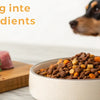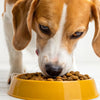How to Get Your Dog to Eat Dry Dog Food: Expert Tips for Picky Eaters
- Houndsy
Table of Contents
- Introduction
- Understanding the Reasons Behind Picky Eating
- Tips to Encourage Your Dog to Eat Dry Dog Food
- Conclusion
Introduction
Have you ever watched your dog turn its nose up at a bowl of dry kibble and wondered, “Why won’t my dog eat?” You're not alone. According to recent studies, nearly 15% of dog owners report their pets being picky eaters at some point in their lives. This can be frustrating, especially when we know how vital a balanced diet is for our furry friends. Understanding how to encourage your dog to eat dry dog food can make a significant difference in their health and happiness.
In this blog post, we’ll explore the various reasons behind a dog’s reluctance to eat dry kibble and provide you with actionable tips to help encourage a healthier eating routine. From examining potential health issues to exploring creative feeding techniques, we’ll cover all the bases to simplify and elevate your dog feeding experience. By the end, you’ll have a toolkit of strategies to entice your dog back to their food bowl and ensure they receive the nutrition they need.
Let’s embark on this journey together, keeping our beloved dogs’ well-being at the forefront.
Understanding the Reasons Behind Picky Eating
Before we dive into the solutions, it's essential to understand the various factors that could contribute to your dog's reluctance to eat dry food.
Health Issues
One of the first considerations should always be your dog's health. Sudden changes in appetite can indicate underlying medical issues. Here are some common health-related causes:
- Dental Problems: Pain from dental issues can make eating uncomfortable. Dogs with tooth decay, gum disease, or broken teeth may avoid dry kibble due to discomfort.
- Gastrointestinal Disturbances: Conditions like gastroenteritis or pancreatitis can lead to a loss of appetite. Look for signs like vomiting, diarrhea, or lethargy.
- Chronic Illness: Conditions such as kidney disease or diabetes can also affect appetite. If your dog’s eating habits have changed suddenly, a vet visit is advised.
Behavioral Factors
Behavioral issues often play a significant role in a dog's eating habits. Here are some key factors to consider:
- Stress and Anxiety: Any changes in the environment—new family members, moving houses, or loud noises—can lead to anxiety that affects appetite.
- Spoiling: If your dog is accustomed to table scraps or treats, they may refuse dry food in favor of tastier options.
- Feeding Environment: Dogs thrive on routine and a calming feeding area. If mealtime is chaotic or distracting, your dog may be too stressed to eat.
Food-Related Factors
Sometimes, the issue lies with the food itself. Consider the following:
- Quality of Food: Not all kibble is created equal. Low-quality kibble may lack the flavors and nutrients that entice dogs to eat.
- Boredom: Dogs can get bored with the same food. If you've been feeding the same kibble for a long time, it might be time for a change.
Tips to Encourage Your Dog to Eat Dry Dog Food
Now that we understand the reasons behind picky eating, let's explore practical tips to encourage your dog to eat dry dog food.
1. Assess and Address Health Concerns
The first step in solving your dog’s reluctance to eat should be a visit to the veterinarian. Ensuring that your dog is healthy will provide peace of mind and establish a baseline for any further changes you make to their diet.
2. Create a Positive Feeding Environment
Establish a calm and consistent feeding area. Make sure the space is quiet and free from distractions, allowing your dog to focus on their meal.
3. Gradual Transitioning
If you’re switching to a new kibble, do so gradually. Mixing the new food with the old in increasing proportions over several days can help your dog adjust without feeling overwhelmed.
4. Make Kibble More Appealing
Enhancing the palatability of dry food can often work wonders. Here are a few ways to do this:
- Warm It Up: Warming the kibble slightly can enhance its aroma, making it more enticing. Just be sure it’s not too hot!
- Add Toppers: Consider adding dog-safe toppers like plain yogurt, canned pumpkin, or low-sodium chicken broth. These additions can add flavor and make the meal feel special.
- Mix in Wet Food: If your dog is particularly stubborn, try mixing a small amount of wet dog food with their kibble. This combination can create a more appealing texture and flavor.
5. Stick to a Feeding Schedule
Feeding your dog at the same time each day helps establish a routine. Leave the food down for 30 minutes. If your dog doesn’t eat, remove the food until the next scheduled meal. This can help encourage them to eat when they realize that food won’t always be available.
6. Limit Treats and Snacks
If your dog is receiving a lot of treats or table scraps, their appetite for dry food may diminish. Limit treats to no more than 10% of their daily calorie intake.
7. Explore Different Kibble Brands
If your dog refuses to eat their current kibble, it may simply not be to their liking. Experiment with high-quality kibble options that contain different flavors or protein sources.
8. Stay Consistent with Food Types
Once you find a kibble that your dog enjoys, stick with it for a while. Dogs thrive on routine, and frequent changes can cause confusion and reluctance to eat.
9. Interactive Feeding Tools
Consider using an interactive feeding tool, like a slow feeder or puzzle bowl. These can engage your dog mentally and make mealtime more exciting.
10. Consult with a Professional
If your dog’s eating habits do not improve, consult a veterinarian or a pet nutritionist. They can provide personalized guidance based on your dog's specific needs.
Conclusion
Getting your dog to eat dry dog food doesn’t have to be a battle. By understanding the underlying reasons for their reluctance and applying these strategies, we can create a more enjoyable and healthy feeding experience for our furry companions. Remember, a happy dog is a well-nourished dog.
If you’re looking for a way to elevate your feeding routine further, consider the Houndsy Kibble Dispenser. Our beautifully designed dispenser not only provides perfect portions but also complements your home decor. Explore the Houndsy Kibble Dispenser and discover how it can transform your dog feeding experience today!
FAQ
Why is my dog suddenly refusing to eat dry food?
There can be various reasons ranging from health issues, stress, or simply disliking the food. It's essential to consult with a veterinarian if the change in appetite is sudden and persistent.
How can I tell if my dog is being picky or has a health issue?
Observe your dog for other symptoms such as lethargy, vomiting, or changes in behavior. If you notice any concerning signs, it's best to take your dog to the vet for a thorough check-up.
Can I mix wet food with dry food to entice my dog to eat?
Yes! Mixing wet food with dry kibble can make the meal more appealing to picky eaters. Just be cautious about the overall calorie intake.
What are some healthy toppers I can add to kibble?
Safe options include plain yogurt, unsweetened canned pumpkin, or low-sodium broth. Always ensure that any additions are dog-friendly and consult your vet if unsure.
How can I improve my dog's eating environment?
Make mealtime quiet and calm. Remove distractions, establish a feeding routine, and ensure the bowl is in a comfortable, accessible location for your dog.
What should I do if my dog hasn’t eaten for more than 24 hours?
If your dog refuses to eat for more than a day, it’s crucial to consult with your veterinarian. Prolonged lack of appetite can lead to serious health complications.












